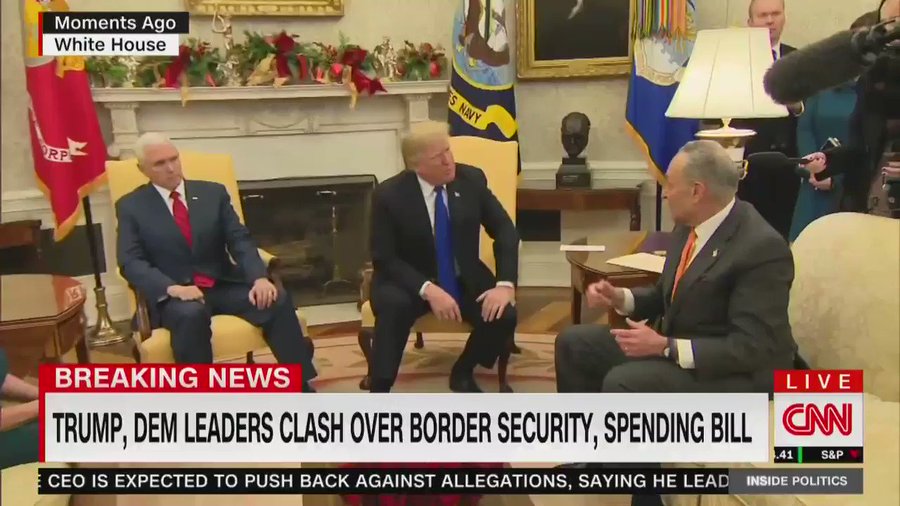Esquire
It’s OK to Say the President Is More Dishonest Than Other Politicians. It’s the Truth.
America’s Fact-Checkers met the Trump Oval Office Challenge with good work and Both Siderism.
By Jack Holmes January 9, 2019
 Getty ImagesPool
Getty ImagesPool
We were blessed last night as, like a legendary but aging rock band that’s on tour supporting a feckless new album, President Trump just played the hits in his big Oval Office speech. El Jefe mostly trotted out the same old fabrications from his rallies, as he portrayed undocumented immigrants as violent criminals (they do not commit more crimes than native-born Americans) and suggested The Wall would pay for itself, because drugs and trade deals. He did not, thankfully, declare a state of emergency and embark on a campaign to abuse the power vested in him for nakedly political gain. Also, he calmly read aloud from the teleprompter, which apparently sent his aides over the moon. The bar just got ten feet lower.
It was also a decent evening for The Fact-Check Industry. The Washington Post published a fact-check “cheat sheet” before the speech, which was useful and effective because it operated on the premise—based on a huge body of evidence—that the president would repeat his standard false claims about the situation at the border, and offered viewers a way to cope. Across the board, networks sought to assess the truth of the president’s claims right after he finished. CNN hosted the Toronto Star‘s Daniel Dale, the LeBron of the genre, in the immediate postgame to point out the reheated falsehoods he’d served up. This was better than trotting out Rick Santorum, whom CNN pays to defend the president no matter what he says or does. That came later.
But alas, the night was not immune to some of the structural issues afflicting The Media and its coverage of Our National Discourse.
The impulse to grant Both Sides legitimacy in every single argument, regardless of whether their claims are tethered to reality, dies very hard indeed. Perhaps more accurately, the drive to avoid accusations of bias from the right is immortal. It is a simple fact that Donald Trump, American president, shut down the government. He said he was going to shut down the government:
And then he did.
The person responsible for “the budget impasse,” then, is Donald Trump. He created the impasse by refusing to sign any bill that did not fund The Wall. Senate Republicans passed a funding bill in December to keep government open, and Speaker Paul Ryan was ready to bring it to a vote in the then-Republican House. But it did not include Wall funding, and Rush Limbaugh started saying bad things about Donald Trump on the television. So Trump went nuclear.
Never mind that a majority of Americans reject The Wall, and Trump campaigned on building it to combat a supposed “invasion” at the southern border in the 2018 midterms only to see his party to get trounced. He has no mandate to Build The Wall, yet he took the government hostage and demanded $5.7 billion to release it. In the AP’s assessment, the other side is equally responsible for refusing to pay the ransom.
This intriguing logic was evident elsewhere. When Democrats took control of the House last week, they passed a funding bill very similar to the Senate Republican bill from December, though it split Homeland Security funding into a separate, stopgap bill. This would allow Senate Republicans to vote to reopen the government with assurance the border-security debate would be revisited in the shorter term. Some House Republicans voted with Democrats to pass it. In other words, this would have reopened the government largely on the terms initially agreed to by both sides before Trump threw a hissy-fit.
For the fact-checkers at NBC News, however, this was a “provocation:”
The facts: House Democrats did pass spending bills to re-open government as their first act upon taking control of the chamber. But the bills were more of a provocation than real legislation; Democrats knew they would not be taken up by the Senate or signed by Trump. Senate Majority Leader Mitch McConnell said in no uncertain terms that any bill that didn’t have obvious support from the White House and Senate majority would not come to his floor for a vote.
“The Senate will not waste its time considering a Democratic bill which cannot pass this chamber and which the president will not sign,” McConnell said.
Notice how this entire thing is framed around the premise of Mitch McConnell’s statement, which might even not be true on the bare facts. If McConnell put the House bill up for a vote, is he positive that four Republicans wouldn’t vote with Democrats to pass it? Or is the risk that could happen the reason he refuses to put it up for a vote? NBC doesn’t ask this question—they accept his claim at face value, even though two Senate Republicans broke the line last week. As the president’s ally, McConnell does not want a bill to pass both houses of Congress without Wall funding, because then Trump will be forced to veto it and very clearly illustrate the reality of the situation: that the president is the one keeping the government shut down.
NBC is right that Democrats knew the bill they passed wouldn’t pass the Senate, but they were only sure of that because McConnell said he wouldn’t allow a vote on it. That doesn’t preclude the House bill from being “real legislation”: they passed a bill similar to one the Republican Senate had previously passed, and which Trump was ready to sign until the right-wing pundits came knocking on his TV screen with pitchforks.
Notice that this Fact-Check by a Neutral, Unbiased Media Referee is making value judgments on what’s “real legislation” and what’s a “provocation,” and framing the discussion based on the prerogatives of the Senate Majority Leader. It’s enough to make you wonder whether people who very closely follow current events form opinions about what’s happening, and those opinions at least subliminally impact how they discuss those events. To the extent being neutral and unbiased is possible, it is not always the same as being honest and fair.
Checking whether what any politician of any party says is true is a vitally important function of journalism, but it is not necessary to always find that Both Sides Are Fudging. In this case, it’s something of a performance, to show the Democratic response to Trump’s predictable parade of nonsense has also been Subjected to Scrutiny. It feels like an attempt to even the scales. After all, NBC fact-checked three more claims from The Response in that article. It found two to pretty much be accurate. In the fourth instance, NBC suggested Schumer’s characterization of The Wall as 30-feet high did not do justice to Candidate Trump’s inane ramblings, which sometimes put it as high as 65 feet. Is this serious? It’s hard to tell.
Elsewhere, The New York Times dinged Schumer for suggesting the shutdown was hurting “millions of Americans,” as a Fact-Checker suggested only 800,000 federal workers have been furloughed. But Schumer didn’t say federal workers, he said Americans, and the Times‘ own reporting indicates he is probably right. Regardless, those 800,000 workers have families. It’s OK to say the president is more dishonest than other politicians. It’s the truth, and he and his allies will attack you either way.

























 She’s beautiful.
She’s beautiful.  Federal officials report that at least $10 million has been stolen in 2018 by scammers posing as Social Security Administration employees. Shauna Bittle/Sun-Times.
Federal officials report that at least $10 million has been stolen in 2018 by scammers posing as Social Security Administration employees. Shauna Bittle/Sun-Times.